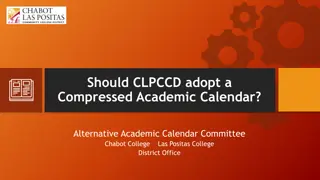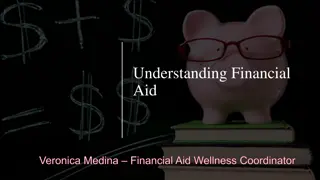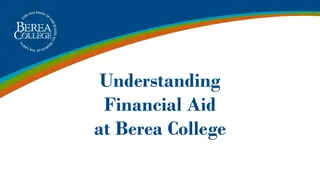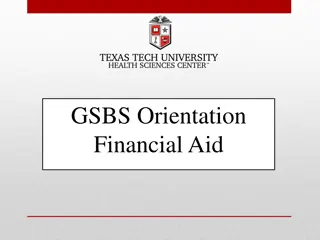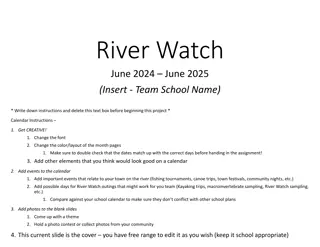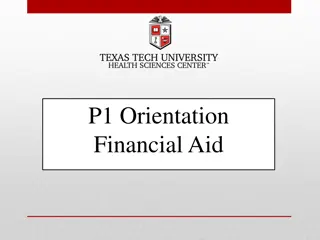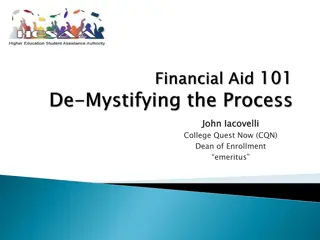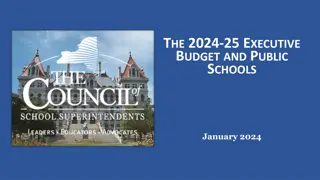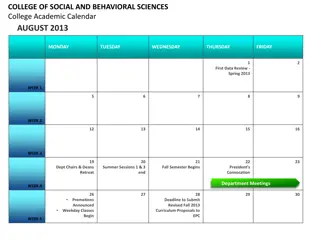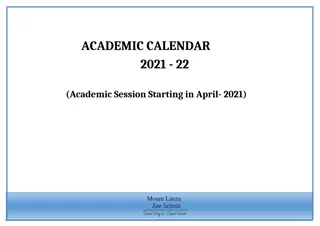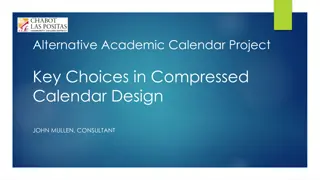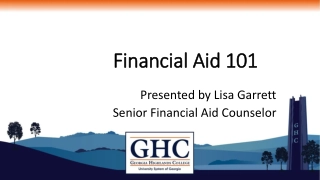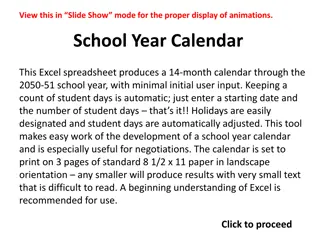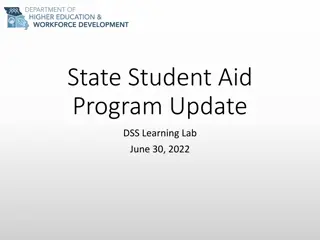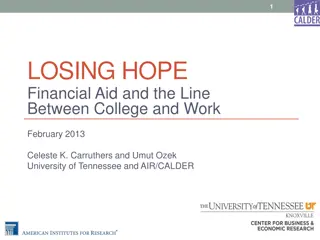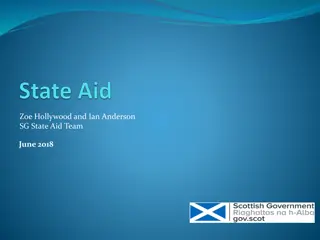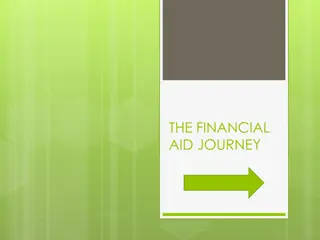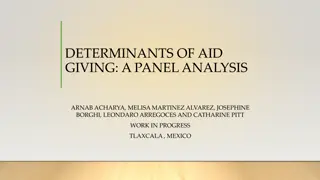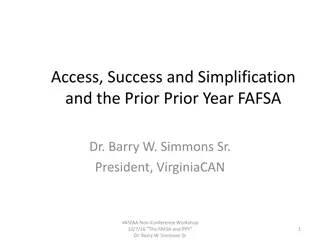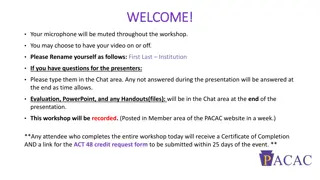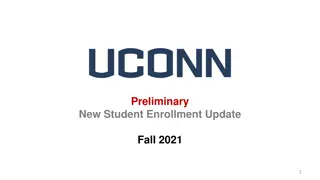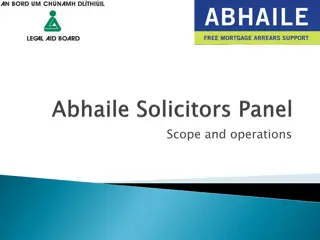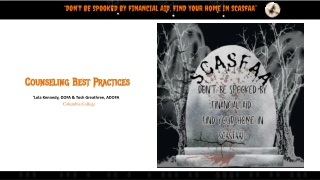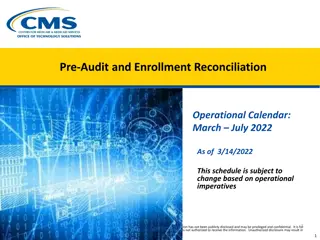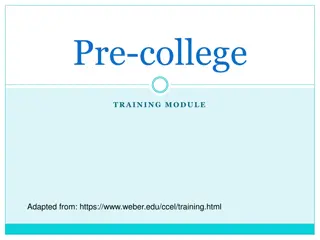Understanding Academic Calendar Changes and Financial Aid Impact
Explore how academic calendar shifts affect financial aid, including types of academic calendars, COVID-19 flexibilities, and implications on awards, SAP, and disbursement. Get insights on standard vs. non-standard terms and non-term programs.
Download Presentation

Please find below an Image/Link to download the presentation.
The content on the website is provided AS IS for your information and personal use only. It may not be sold, licensed, or shared on other websites without obtaining consent from the author. Download presentation by click this link. If you encounter any issues during the download, it is possible that the publisher has removed the file from their server.
E N D
Presentation Transcript
When the Axis Shifts: Academic When the Axis Shifts: Academic Calendar Changes and the Impact Calendar Changes and the Impact on Financial Aid on Financial Aid Presented By: Dr. Samuel O. Chuks HEAG Consultant October 28, 2020
Agenda Academic Calendar Types: Back to Basics Related Critical Concepts Relevant COVID 19 & DOE Flexibilities Academic Calendar Changes: What to Look For Impact of Academic Calendar Changes on Awards, SAP, and Disbursement Technology Considerations Information Sharing Opportunities Q&A Poll Questions Throughout!!!
Academic Calendar Types: Back to Basics Standard Term: Minimum statutory AY definition: 24 semester/trimester or 36 quarter credit hours, 30 weeks* Term in a period in which all classes start and end within a set time Academic progress is measured in credit-hours A semester or trimester = 14 to 21 weeks in length A quarter = 9 to 13 weeks in length Can be semester, trimester or quarter terms UG Full-time defined as12 Semester, 12 Trimester, or 12 Quarter Credit-Hours Graduate Full-time defined by institution *COVID flexibilities require DOE approval for AY of less than 30 weeks
Academic Calendar Types: Back to Basics Non-Standard Term: Minimum statutory AY definition: 24 semester/trimester or 36 quarter credit hours, 30 weeks* Term in which all classes start and end within a set time Terms that are not semester, trimester, or quarter terms One or more terms shorter or longer than allowed range for standard terms Full-time enrollment defined as less than 12 credit hours during one or more terms Program awards credit hours not associated with the length of the term Exceptions include summer, intersessions Terms usually of unequal length, though terms of equal length may also be considered nonstandard Caution: Beware of Substantially Equal requirements (SE9W, SE, NSE) *COVID flexibilities require DOE approval for AY of less than 30 weeks
Academic Calendar Types: Back to Basics Non-Term: Minimum statutory AY definition: 900 hours, 26 weeks for clock hour non-term programs; 24 credits, 30 weeks for credit hour non-term programs. A program administered without the use of terms Academic Progression is at the student s pace Disbursement depends on completed hours and weeks All clock hour programs are Non-term programs Some credit hour programs are Non-term programs
Related Critical Concepts What year is it anyway? Award Year (July 1 through June 30) Academic Year (Defined by Institution, Program Specific) Scheduled AY (SAY: Fixed Period (i.e. Fall/Spring) Borrower Based AY (BBAY: Non-Fixed Period (i.e. 900 Clock Hours) Fiscal Year (Defined by Institution) 10/1-9/30; 1/1-12/31; 7/1-6/30 Module (AKA: Blocks, Mini-Sessions, Mini-Terms) Any course that does not extend the full length of the term Multiple Modules can overlap within a term Intersession occurs between two terms Can be a stand-alone non-standard term Can be a module attached to a standard term (considered standard term)
Related Critical Concepts Pell & Loan Treatment cont. Term Type Pell Formula Direct Loan Treatment Standard Pell Formula 1,3 SAY, BBAY1, BBAY2 SE9W Non-Standard Term Pell Formula 3 SAY, BBAY1, BBAY2 SE Non-Standard Term Pell Formula 3 BBAY3 NSE Non-standard Term Pell Formula 3 BBAY3 Non-Term Pell Formula 4 BBAY3
Relevant COVID19 & DOE Flexibilities Applicable through the end of the academic year that includes December 31, 2020 or the end of the academic year that includes the end date for the COVID-19 federally declared emergency, whichever occurs later. References: https://www.ed.gov/coronavirus/program-information#highered https://www.nasfaa.org/covid19 Highlights: Terms permitted to overlap with an adjacent term without the program becoming nonterm Semester or Trimester can contain as few as 13 weeks Quarters can contain as few as 9 weeks COD updates not required if loan periods end on original term end date
Academic Calendar Changes: What to Look For In order to safely and effectively deliver educational programs, many schools have had to change their academic calendars and institutional characteristics. Pay close attention to the following potential institutional characteristics: 1. 2. 3. 4. 5. Decreased weeks of instructional time Deferred Start Dates The addition of Intersessions Transition to Modules Increasing the Frequency of Start Dates
Examples of Academic Calendar Changes Standard Term (Semesters/Trimesters) 15 week semester Sept 7 Dec 20 15 week semester Jan 5 May 15 Still Standard Term Calendar change Oct 6 Jan 4 = 13 weeks Still Standard Term Calendar change Oct 12 Jan 10 = 13 weeks overlapping *Apply same concept to standard terms using quarters with a minimum of 9 weeks
Impact of Academic Calendar Changes on Awards, SAP and Disbursement Impact on Awards 1. Changing from a standard fall-spring term to trimester, quarter, modular or clock hour program may impact award amounts. Students in non-term and certain non-standard term programs must successfully complete the credit or clock- hours and weeks of instructional time to receive subsequent disbursements. Students who enroll in, but don t attend a module may not receive financial aid assistance for that module. 2. 3.
Impact of Academic Calendar Changes on Awards, SAP and Disbursement Impact on SAP 1. Timing for SAP evaluation may be different if Academic Calendars change. SAP waivers due to Covid-19: Courses not completed can be excluded from PACE and Maximum Timeframe. SAP Appeal policies may change to include COVID19 extraordinary circumstances. 2. 3.
Impact of Academic Calendar Changes on Awards, SAP and Disbursement Impact on Disbursement 1. For non-term clock hour programs, student must still successfully complete all hours and weeks to receive next disbursement. Student loan progression and amount may be impacted for non-term and certain non-standard term academic programs. 2.
Technology Considerations The use of technology has never been more important. The following questions should be discussed with all relevant campus personnel: How will you manage Academic Calendar Changes related to: 1. 2. 3. 4. 5. 6. 7. Term/Period of Enrollment Start/End dates? Census/Add/Drop dates? Incomplete Coursework Deadlines? Grade Changes? SAP evaluation dates? Disbursement Dates? Aid Year rollover/System Upgrades when students are still progressing through the current aid year (i.e. nonterm programs)
Information Sharing Campus decision makers should discuss and distribute updates related to: 1. 2. 3. 4. 5. 6. 7. 8. 9. 10. Disbursement Dates? 11. Aid Year rollover/System Upgrades when students are still progressing through the current aid year (i.e. nonterm programs) Term/Period of Enrollment Start/End dates? Census/Add/Drop dates? Holiday/Break Periods Incomplete Coursework Deadlines? Grade Changes? SAP evaluation dates? SAP Policy Changes Withdrawal Policies Enrollment Status Changes
Opportunities Opportunities 1. Minor changes may still allow for the use of easier Pell Formula 1 and streamlined disbursement. Grade Level Progression for standard term programs easier, not so for non-term and some non-standard term programs. Professional growth and training for Financial Aid staff. Increased collaboration across departments. Online or Hybrid learning opportunities. SAP waivers for students. Flexibility for students and families. 2. 3. 4. 5. 6. 7.
HEAG Contacts: Karyn Wright-Moore VP, Compliance and Quality Assurance kwrightmoore@heag.us Dr. Samuel O. Chuks Financial Aid Consultant schuks@heag.us Jeff Megargell Intake Coordinator jmegargell@heag.us HEAG, Inc. 60 Walnut Street, 4th Floor Wellesley, MA 02481


